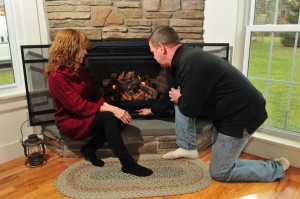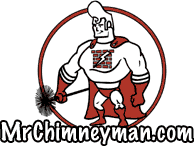[sws_toggle1 title=”How is Mr. Chimney Man Different?”] 25 years of experience. Not just in an office, but on every job site from start to finish. David Doherty is currently the only Chimney Services Institute of America www.csia.org Certified Chimney Sweep in Onondaga County working as an owner operator. That means you get David Doherty on EVERY job, from start to finish. Not every sweep has the knowledge and technology to provide quality service. Because the chimney sweep industry is not regulated, virtually anyone can start a business and call himself or herself a sweep. The services sweeps provide help keep your family and home safe. When you choose Mr. Chimney Man, you get state-of-the-art equipment to inspect and sweep your chimney and the expertise to get the job done right. [/sws_toggle1]
25 years of experience. Not just in an office, but on every job site from start to finish. David Doherty is currently the only Chimney Services Institute of America www.csia.org Certified Chimney Sweep in Onondaga County working as an owner operator. That means you get David Doherty on EVERY job, from start to finish. Not every sweep has the knowledge and technology to provide quality service. Because the chimney sweep industry is not regulated, virtually anyone can start a business and call himself or herself a sweep. The services sweeps provide help keep your family and home safe. When you choose Mr. Chimney Man, you get state-of-the-art equipment to inspect and sweep your chimney and the expertise to get the job done right. [/sws_toggle1]
[sws_toggle1 title=”Exactly What Does a Chimney Sweep Do?“]The primary job of a chimney service professional is to aid in the prevention of fires related to fireplaces, wood stoves, gas, oil and coal heating systems and the chimneys that serve them. Chimney sweeps install, clean and maintain these systems, evaluate their performance, prescribe changes to improve their performance, and educate the consumer about their safe and efficient operation.
In doing their primary job of inspecting and sweeping chimneys, chimney professionals also function as on-the-job fire prevention specialists. They are constantly on the lookout for unsafe conditions that can cause home fires or threaten residents with dangerous or unhealthy indoor air quality.
[/sws_toggle1]
[sws_toggle1 title=”How Does a Fireplace Work and What Does Soot or Creosote Come From? “]
As a fire burns in a fireplace, the air from the room goes through the grate and fuels the fire. The fire releases numerous gases, which rise naturally since they are lighter than the surrounding air. These gases then escape up the chimney and are released into the atmosphere. As these substances (millions of tiny particles of ash and carbons etc..) pass through the chimney, they cool and condensation appears on the inside surface of the flue lining. The condensation mixes with the particles and a substance commonly referred to as soot begins to accumulate on the walls.
In many cases, a flammable substance called creosote (tar creosote) may build up in the chimney and can fuel a chimney fire
The gradual accumulation of soot can seriously affect the way your chimney performs. Thick layers of soot can physically restrict the flue so there is no longer enough free area to vent the fireplace properly. Consider that a 1/2″ buildup will restrict the airflow by 17% for a typical masonry fireplace chimney, and by a whopping 30% for the average prefabricated chimney.
Mr. Chimney Man inspects your fireplace and chimney with state-of-the-art video and photographic technology. He identifies any and all design flaws and safety hazards. Finally, in consultation with you, provides recommendations for maintenance or repairs at a cost you can afford.
[/sws_toggle1]
[sws_toggle1 title=”How Often Should I Have My Chimney Cleaned?“]
The answer to this question depends on what fuel you use. It also depends on the age of your home, the condition of your chimney, and the weather (mild winters cause more problems than cold ones). Generally, if you use wood, the chimney should be cleaned at least every 12 months (more often if you burn three or more cords of wood, or if you burn green wood).
Problems in the furnace or boiler can cause highly sooty conditions in the chimney. Even though natural gas is a clean-burning fuel, today’s high-efficiency gas furnaces create special problems. The fumes they produce are cooler and produce higher levels of water vapor than previous models, and this vapor in turn produces more water condensation. These vapors also contain chlorides from house-supplied combustion air, which combine to form hydrochloric acid. The acid-water condensates from these latest natural gas furnaces cause more flue deterioration than previous models. It’s important to check these systems at least each year. (Get Started)
[/sws_toggle1]
[sws_toggle1 title=”Do I Need to Have My Chimney Swept if I Have a Gas Fire? “]
Yes, although less frequently. Blockages in chimneys connected to gas fires can lead to a build-up of carbon monoxide and other harmful gases. Upon the initial evaluation of your system, Mr. Chimney Man can advise how often your chimney should be swept.
[/sws_toggle1]
[sws_toggle1 title=”Will There Be A Mess at My Home? “]
No. Mr. Chimney Man uses a powerful vacuum that prevents soot and dust from entering the home, and is careful to take precautions in order to prevent any mess.
[/sws_toggle1]
[sws_toggle1 title=”Do I Need to Be Home? “]
Yes. Fireplace and furnace flue sweeps take place on the inside of the home, and sometimes also from the outside. It is best if the homeowner is home so Mr. Chimney Man can explain his planned activities and any and all recommendations for repair or maintenance.
[/sws_toggle1]
[sws_toggle1 title=”How Long Does a Chimney Cleaning/ Inspection Take? “]
A chimney cleaning usually takes 30 minutes to an hour to clean and fully evaluate. Mr. Chimney Man strongly recommends that the homeowner stay present in the home during this time so that he may relay his findings or any recommendations for repair or maintenance.
[/sws_toggle1]
[sws_toggle1 title=”What if it Rains or Snows on the Day of the Appointment?“]
Most all sweeping and inspections can be accomplished from inside the home. If snow or heavy rain in the forecast limits the ability to perform the job completely, Mr. Chimney Man will call to reschedule.
[/sws_toggle1]
[sws_toggle1 title=”May I Go Up on the Roof and Check the Chimney With Mr. Chimney Man? “]
For insurance reasons, Mr. Chimney Man is not permitted to allow customers on ladders or on any staging. Mr. Chimney Man does, however, use digital cameras to take photos and videos of your chimney so that you or your insurance company can see any damage or safety risks. You may view the photos on the spot and Mr. Chimney Man can immediately send this evidence to you digitally.
[/sws_toggle1]
[sws_toggle1 title=”Should I Be Concerned About Carbon Monoxide Poisoning? “]
Carbon monoxide is especially dangerous because it is not easily detected. The symptoms of carbon monoxide poisoning are often mistaken for common illnesses such as headaches, nausea, fatigue, or even depression. Carbon monoxide detectors are now readily available and no home should be without at least two of them: one near the furnace and another near the sleeping area of the home. Detectors are NOT a substitute for routine maintenance, but can be a lifesaver should problems occur.
Carbon monoxide problems are always caused by poor ventilation, and blocked chimneys are one of the largest single causes of carbon monoxide in the home. Without proper maintenance, heating systems can be dangerous because they can cause fires or release toxic gases into your living area that cause serious damage, illness, or even death. Poor ventilation is the cause, so it’s critical to have a clean chimney. If you have a venting issue with your chimney, call Mr. Chimney Man to ensure proper and safe diagnosis and repair
[/sws_toggle1]





